Transitions between our paragraphs and chapters create a cohesive and comfortable reading experience for our readers!
Transitions:
- Create relationships between ideas
- Give the reader directions on how to piece together information in a logical way
- Can encourage the reader to think and react in a certain way to what you are writing
Transitions help readers understand how your story fits together and flows.
Signs you need to add more transitions into your writing
- When you read your work back (or someone else provides you with feedback) and the story feels jumpy, choppy or confusing.
- You have written the way you have thought – jumping around from bit to bit.
- You have written your story in bits and pieces and then pasted them all together and now it feels disjointed.
Organisation is key
The flow of your story depends largely on the structure of the parts that make it. It is important to take time to map out the structure of your story so that you can focus on including the information you wish to impart in the correct order.
Let’s look at an example for a solo book project. You may wish to include an Introduction on why you chose to write the book, the purpose and perhaps even a ‘how to use’ section. You will then break your book up into various chapters that are like neatly organised containers for your ideas, teachings, thoughts, etc. At the end of your book you may wish to include an Epilogue, a neat ending that ties a ribbon on your book as a whole. This can be followed by an ‘About the Author’ section, an Index, Acknowledgements, etc.
If you are writing a single, shorter piece of work (like a chapter in a multi-author book project) then you would need a beginning, a middle and an end (just the same as any story ever written or told). The beginning sets the time, place, scene for the whole story. As you transition from the beginning to the middle you will start to share the challenges and victories of the character in greater depth. As you transition from the middle to the end you will start to share lessons learned as a result of the journey and arrive at a conclusion, decision, closing thought – maybe even a call to action.
There is no substitute for clear organisation. Transitions make your story easier to follow.
Transition types
Many kinds of transitions exist, and they can be made up of a single word, a sentence or a whole paragraph.
The transition has two jobs. The first is to imply a summary of the piece of writing before it or to directly summarise the content. The second is to guide the reader to anticipate what is coming up.
- Transitional paragraphs – these may be necessary in longer pieces of work. Transitional paragraphs summarise the information the reader has just received before preparing them to move on to the next.
- Transitional sentences – these can be used when you have done an excellent job of organising your writing into clear and logical paragraphs. Transitional sentences guide the reader from one paragraph to another. They can be at the end of the first paragraph or at the beginning of the next.
- Transitions within the same paragraph – these act as signposts for the reader to guide them to anticipate what is coming up. Within paragraphs these transitions tend to be short sentences or single words.
Transitional words and phrases
In order to successfully add transitions into your work you will need to identify which words will best show your reader the logical flow you wish to share.
Some examples of transition words are:
- However
- Therefore
- Consequently
- For example
- Then
You will need to ensure that you vary the transition words that you use in your writing so as not to make it repetitive for the reader.
Take the time to think about the best transitions for each piece that will help move your readers through the flow of your writing.
For more valuable resources to support you on your writing, publishing and marketing journey I invite you to check out The Authors’ Library.
Want to join a community of like-minded individuals just like you who will lift you up and inspire you? Join us inside The Authors’ Lounge today.




